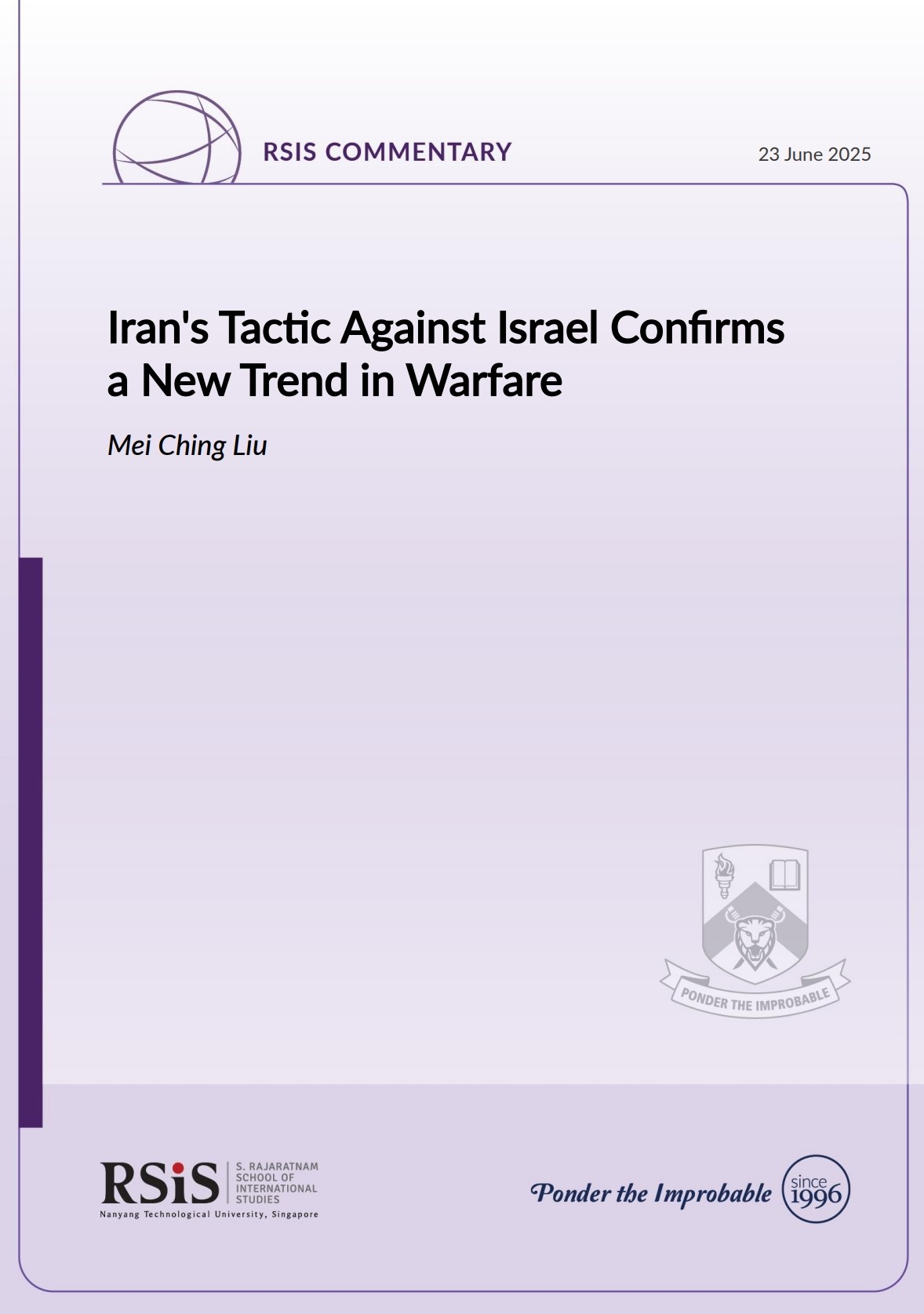23 June 2025
- RSIS
- Publication
- RSIS Publications
- Iran’s Tactic Against Israel Confirms a New Trend in Warfare
SYNOPSIS
Iran’s retaliatory attacks against Israel closely mirrored a tactic used by Russia in Ukraine, i.e., saturating air defences with drones and then following up with missile strikes. This tactic can overwhelm even the most advanced air defence systems. Therefore, defence planners need to rethink current approaches in air defence to counter this new trend.

COMMENTARY
After Israel’s strikes involving more than 200 jets last Friday (Jun 13), Iran responded by launching about 100 drones. Drones launched from Iran can take up to nine hours to reach targets in Israel and most were intercepted by Israeli air defences.
Some observers described this initial Iranian response as “underwhelming”. However, such an assessment holds only if the drone attack is viewed in isolation, without considering the missile barrage launched just hours later.
Iran’s initial drone campaign was likely not intended to deliver immediate harm or damage against Israel. Israel’s multi-layered air defence systems are sophisticated and each system – including Iron Dome, David’s Sling and the Arrow system – is designed to counter different types of aerial threats.
Rather, its objective was to saturate Israel’s air defences and to pave the way for more damaging follow-on missile strikes.
This type of attack closely mirrors Russia’s drone-and-missile playbook in Ukraine.
Saturate Air Defences, Create Fear
While Ukraine has shown its resourcefulness in using drones, Russia’s tactics have also evolved in recent months. Prior to September 2024, the average number of weekly drone launches was around 140, but over the past six months, this figure has peaked at about 1,100 per week.
On Tuesday, Russia reportedly launched 440 drones and 32 missiles, in one of the deadliest strikes on Kyiv since Russia invaded its neighbour in February 2022.
By combining drones with more sophisticated ballistic and cruise missiles, Russia has been able to test the readiness of Ukraine’s air defence network. More importantly, this forces Ukraine to spend limited defence resources to intercept them, gradually eroding Ukrainian defensive capacity.
Iran appears to be adopting the same drone-and-missile strikes not only to saturate air defences but also bring terror to the civilian population.
Despite Israel’s advanced air defence systems and US support, Iranian drones and missiles still managed to breach them, inflicting damage on civilian infrastructure and causing civilian casualties.
Civilians emerging from shelters after Iranian retaliatory attacks were reportedly shocked, with some asking how long the Iranian attacks would continue. There’s undoubtedly a psychological element to it too: Air raid sirens blare several times a day, and parts of the map are awash in red on alert apps.
Drone and Missile Attacks Will Continue
How long can Iran sustain a saturation campaign based on sheer numbers?
Iran is likely to retain the capacity to continue such tactics. It has reportedly fired over 400 missiles and over 1,000 drones so far. Dan Caldwell, a former senior adviser to US Defense Secretary Pete Hegseth, suggested on X that the number of Iranian missiles capable of hitting Israel was closer to 2,000, as well as thousands of drones.
In January, Iran’s army reportedly received a delivery of 1,000 domestically produced drones, with a range of over 2,000km. However, Iran will likely deploy these drone swarms more strategically (unlike Russia, which has launched continuous drone campaigns against Ukraine without a single uninterrupted three-day pause).
Critical energy infrastructure would be a strategic target, as Russia has done in Ukraine. Russia consistently targeted Ukraine’s energy infrastructure during the winter of 2022-2023, in order to disrupt essential heating and water supplies to the civilian population.
Following the initial drone and missile strikes, Iran further retaliated by targeting the oil refinery in Haifa Bay. The strike caused severe damage to the facility’s central power plant and resulted in a suspension of operations.
Israel, anticipating the possibility of another attack on its oil refineries, has already pre-emptively suspended operations at Chevron’s offshore Leviathan natural gas field.
With Israel having targeted four energy-related assets in the current conflict – the Shahran fuel terminal, the Tehran Oil Refinery in southern Tehran’s Shahr Rey district, the Phase 14 processing facility of the South Pars gas field, and the Fajr-e-Jam natural gas processing plant – Iran could deploy a drone-and-missile strike against another energy infrastructure in the coming days.
Shifting Calculus on the Cost of War
Next, there is the question of how long Israel can withstand the sustained drone-and-missile strikes.
At present, apart from Israeli air defence systems, American naval destroyers and ground-based missile batteries are helping Israel to defend itself against the Iranian retaliation.
But interceptor missiles often cost hundreds of thousands of dollars each, while drones cost only between US$20,000 to US$50,000.
Iran could shift the war cost calculus by forcing Israel and its backers to expend expensive munitions on cheap, mass-produced drone threats.
If the Israel-Iran war drags on, it will be worth watching whether key voices within US President Donald Trump’s Make America Great Again (MAGA) movement can prevail.
Conservative commentator Tucker Carlson suggested that the US should “drop Israel. Let them fight their own wars.” Republican lawmaker Marjorie Taylor Greene posted on X that “Anyone slobbering for the US to become fully involved in the Israel/Iran war is not America First/MAGA.”
While the US is unlikely to withdraw its assistance to Israel, it could add pressure on the Trump administration to urge Israel to swiftly end its offensive.
Lessons for Other Countries
As countries watch how the events in Israel and Iran unfold, the lessons are clear for defence planners.
A new trend has emerged from both the Russian-Ukraine and Israel-Iran wars: Saturating the skies with low-cost, expendable drones can overwhelm even the most advanced defence systems.
Such a strategy can not only strain defensive capabilities but also serve to terrorise civilian populations (notwithstanding that acts or threats of violence with the intent to spread terror among the civilian population is prohibited under the laws of war).
So, air defence has become a battle of resource management. Warring parties employing drone-and-missile tactics are shifting the cost calculus in their favour, forcing the enemy to expend limited, expensive munitions on cheap aerial threats.
There may be difficult choices about which aerial threats to intercept and which to let through. Defenders may be forced to accept that it is both impossible and impractical to counter every incoming aerial threat. A risk-based approach may become necessary – prioritising the protection of critical infrastructure, such as power plants and energy grids, while deliberately leaving lower-priority infrastructure less protected.
For civilians living in areas deemed less critical, this could mean enduring the constant fear and uncertainty that their homes and residential areas may receive limited protection in an era of aerial warfare defined by sheer volume and the willingness to deploy cheap systems to break expensive air defences.
So, defence planners need to rethink air defences in order to counter the risks of drones saturating the skies.
About the Author
Mei Ching Liu is an Associate Research Fellow with the Military Transformations Programme at the S. Rajaratnam School of International Studies (RSIS), Nanyang Technological University (NTU), Singapore. This commentary was published by CNA on 20 June 2025. It is republished with permission.
SYNOPSIS
Iran’s retaliatory attacks against Israel closely mirrored a tactic used by Russia in Ukraine, i.e., saturating air defences with drones and then following up with missile strikes. This tactic can overwhelm even the most advanced air defence systems. Therefore, defence planners need to rethink current approaches in air defence to counter this new trend.

COMMENTARY
After Israel’s strikes involving more than 200 jets last Friday (Jun 13), Iran responded by launching about 100 drones. Drones launched from Iran can take up to nine hours to reach targets in Israel and most were intercepted by Israeli air defences.
Some observers described this initial Iranian response as “underwhelming”. However, such an assessment holds only if the drone attack is viewed in isolation, without considering the missile barrage launched just hours later.
Iran’s initial drone campaign was likely not intended to deliver immediate harm or damage against Israel. Israel’s multi-layered air defence systems are sophisticated and each system – including Iron Dome, David’s Sling and the Arrow system – is designed to counter different types of aerial threats.
Rather, its objective was to saturate Israel’s air defences and to pave the way for more damaging follow-on missile strikes.
This type of attack closely mirrors Russia’s drone-and-missile playbook in Ukraine.
Saturate Air Defences, Create Fear
While Ukraine has shown its resourcefulness in using drones, Russia’s tactics have also evolved in recent months. Prior to September 2024, the average number of weekly drone launches was around 140, but over the past six months, this figure has peaked at about 1,100 per week.
On Tuesday, Russia reportedly launched 440 drones and 32 missiles, in one of the deadliest strikes on Kyiv since Russia invaded its neighbour in February 2022.
By combining drones with more sophisticated ballistic and cruise missiles, Russia has been able to test the readiness of Ukraine’s air defence network. More importantly, this forces Ukraine to spend limited defence resources to intercept them, gradually eroding Ukrainian defensive capacity.
Iran appears to be adopting the same drone-and-missile strikes not only to saturate air defences but also bring terror to the civilian population.
Despite Israel’s advanced air defence systems and US support, Iranian drones and missiles still managed to breach them, inflicting damage on civilian infrastructure and causing civilian casualties.
Civilians emerging from shelters after Iranian retaliatory attacks were reportedly shocked, with some asking how long the Iranian attacks would continue. There’s undoubtedly a psychological element to it too: Air raid sirens blare several times a day, and parts of the map are awash in red on alert apps.
Drone and Missile Attacks Will Continue
How long can Iran sustain a saturation campaign based on sheer numbers?
Iran is likely to retain the capacity to continue such tactics. It has reportedly fired over 400 missiles and over 1,000 drones so far. Dan Caldwell, a former senior adviser to US Defense Secretary Pete Hegseth, suggested on X that the number of Iranian missiles capable of hitting Israel was closer to 2,000, as well as thousands of drones.
In January, Iran’s army reportedly received a delivery of 1,000 domestically produced drones, with a range of over 2,000km. However, Iran will likely deploy these drone swarms more strategically (unlike Russia, which has launched continuous drone campaigns against Ukraine without a single uninterrupted three-day pause).
Critical energy infrastructure would be a strategic target, as Russia has done in Ukraine. Russia consistently targeted Ukraine’s energy infrastructure during the winter of 2022-2023, in order to disrupt essential heating and water supplies to the civilian population.
Following the initial drone and missile strikes, Iran further retaliated by targeting the oil refinery in Haifa Bay. The strike caused severe damage to the facility’s central power plant and resulted in a suspension of operations.
Israel, anticipating the possibility of another attack on its oil refineries, has already pre-emptively suspended operations at Chevron’s offshore Leviathan natural gas field.
With Israel having targeted four energy-related assets in the current conflict – the Shahran fuel terminal, the Tehran Oil Refinery in southern Tehran’s Shahr Rey district, the Phase 14 processing facility of the South Pars gas field, and the Fajr-e-Jam natural gas processing plant – Iran could deploy a drone-and-missile strike against another energy infrastructure in the coming days.
Shifting Calculus on the Cost of War
Next, there is the question of how long Israel can withstand the sustained drone-and-missile strikes.
At present, apart from Israeli air defence systems, American naval destroyers and ground-based missile batteries are helping Israel to defend itself against the Iranian retaliation.
But interceptor missiles often cost hundreds of thousands of dollars each, while drones cost only between US$20,000 to US$50,000.
Iran could shift the war cost calculus by forcing Israel and its backers to expend expensive munitions on cheap, mass-produced drone threats.
If the Israel-Iran war drags on, it will be worth watching whether key voices within US President Donald Trump’s Make America Great Again (MAGA) movement can prevail.
Conservative commentator Tucker Carlson suggested that the US should “drop Israel. Let them fight their own wars.” Republican lawmaker Marjorie Taylor Greene posted on X that “Anyone slobbering for the US to become fully involved in the Israel/Iran war is not America First/MAGA.”
While the US is unlikely to withdraw its assistance to Israel, it could add pressure on the Trump administration to urge Israel to swiftly end its offensive.
Lessons for Other Countries
As countries watch how the events in Israel and Iran unfold, the lessons are clear for defence planners.
A new trend has emerged from both the Russian-Ukraine and Israel-Iran wars: Saturating the skies with low-cost, expendable drones can overwhelm even the most advanced defence systems.
Such a strategy can not only strain defensive capabilities but also serve to terrorise civilian populations (notwithstanding that acts or threats of violence with the intent to spread terror among the civilian population is prohibited under the laws of war).
So, air defence has become a battle of resource management. Warring parties employing drone-and-missile tactics are shifting the cost calculus in their favour, forcing the enemy to expend limited, expensive munitions on cheap aerial threats.
There may be difficult choices about which aerial threats to intercept and which to let through. Defenders may be forced to accept that it is both impossible and impractical to counter every incoming aerial threat. A risk-based approach may become necessary – prioritising the protection of critical infrastructure, such as power plants and energy grids, while deliberately leaving lower-priority infrastructure less protected.
For civilians living in areas deemed less critical, this could mean enduring the constant fear and uncertainty that their homes and residential areas may receive limited protection in an era of aerial warfare defined by sheer volume and the willingness to deploy cheap systems to break expensive air defences.
So, defence planners need to rethink air defences in order to counter the risks of drones saturating the skies.
About the Author
Mei Ching Liu is an Associate Research Fellow with the Military Transformations Programme at the S. Rajaratnam School of International Studies (RSIS), Nanyang Technological University (NTU), Singapore. This commentary was published by CNA on 20 June 2025. It is republished with permission.





